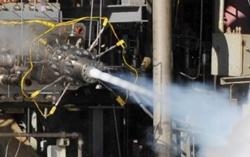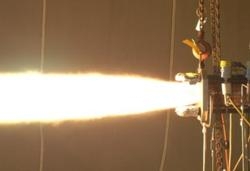Hot-Fire Tests Keep Company On Track For 2019 Delivery
Aerojet Rocketdyne recently completed a successful series of hot-fire tests of key additively manufactured components for its AR1 booster engine at its Sacramento test facility.

The testing of the main injector elements represents another important milestone in the development of the AR1 engine and the company's commitment to having a certified engine in production in 2019.
The AR1 is a 500,000 lbf thrust-class liquid oxygen/kerosene booster engine currently in development as an American-made alternative to engines such as the foreign-supplied RD-180. The 2015 National Defense Authorization Act calls for the Russian-built RD-180 to be replaced by an American-made alternative for national security space launches by 2019.
"We believe the AR1 is the best, most affordable option to eliminate U.S. dependence on foreign sources of propulsion while maintaining assured access to space for our nation's critical national security and civil space assets," said Linda Cova, executive director of Hydrocarbon Engine Programs at Aerojet Rocketdyne.
The AR1 is designed to integrate with the Atlas V launch vehicle, as well as provide a versatile propulsion solution for multiple current and future launch vehicle applications. "When you consider the minimal changes to the Atlas V launch vehicle, launch pad and related infrastructure that are required with an AR1 solution, this approach is clearly the best path toward finding a replacement for the RD-180 and meeting the launch needs of our nation," said Cova. "We look forward to working with the U.S. government in a competitive procurement environment to bring this
engine to market."
The development of AR1 is currently being funded by Aerojet Rocketdyne with assistance from United Launch Alliance (ULA), with engine certification targeted for 2019. The cooperative development of AR1 represents the continuation of a long-standing relationship the companies have had in supporting U.S. launch requirements. Aerojet Rocketdyne and ULA continue to work to reduce costs of propulsion systems that support the Atlas and Delta launch vehicles such as the RS-68A, RL10 and AJ-60A, while maintaining demonstrated 100 percent mission success.

"Aerojet Rocketdyne is committed to delivering an RD-180 replacement by 2019, which is why the company is investing in the engine and inviting the Air Force, ULA and other key stakeholders to all major reviews so that engine certification can occur in parallel," added Cova.
The single-element main injector hot-fire tests were conducted to evaluate various main injector element designs and fabrication methods. Several injectors were fabricated using Selective Laser Melting (SLM), a form of additive manufacturing. Additive manufacturing, also known as 3D printing, enables the rapid production of complex engine components at a fraction of the cost of those produced using traditional manufacturing techniques.
(Images provided by Aerojet Rocketdyne)
 NTSB Final Report: Cessna 177B
NTSB Final Report: Cessna 177B ANN's Daily Aero-Term (05.08.25): Final Approach Fix
ANN's Daily Aero-Term (05.08.25): Final Approach Fix Aero-News: Quote of the Day (05.08.25)
Aero-News: Quote of the Day (05.08.25) ANN's Daily Aero-Term (05.09.25): Estimated (EST)
ANN's Daily Aero-Term (05.09.25): Estimated (EST) ANN's Daily Aero-Linx (05.09.25)
ANN's Daily Aero-Linx (05.09.25)




